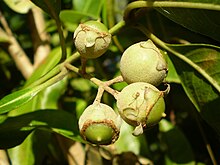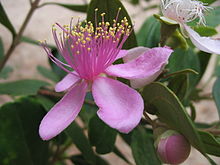Rhodomyrtus
| Rhodomyrtus | ||||||||||||
|---|---|---|---|---|---|---|---|---|---|---|---|---|

|
||||||||||||
| Systematics | ||||||||||||
|
||||||||||||
| Scientific name | ||||||||||||
| Rhodomyrtus | ||||||||||||
| ( DC. ) Rchb. |
Rhodomyrtus is a genus of plants withinthe myrtle family (Myrtaceae). The approximately 23 species occur in tropical Asia , New Guinea , Australia , New Caledonia and Fiji .
description

Appearance and leaves
Rhodomyrtus species grow as evergreen shrubs or trees . The constantly against arranged on the branches leaves are divided into petiole and leaf blade. The simple leaf blades often have three main nerves starting from the blade base.
Inflorescences and flowers
The flowers are individually in the leaf axils or in groups of three to eleven in lateral, zymous or racemose inflorescences .
The hermaphrodite flowers are radial symmetry and four or five-fold with a double flower envelope . The egg-shaped to hemispherical flower cup (hypanthium) hardly protrudes beyond the upper end of the ovary and is fused with it. The four or five free, leathery sepals are durable. The four free petals are larger than the sepals. The colors of the petals range from white to pink to red. The numerous free stamens arranged in three to six circles are usually shorter than the petals. The anthers open longitudinally. Three or four carpels are fused to form a subordinate one to four- chamber ovary. The many ovules are arranged in two rows, usually in central angled or rarely parietal placentation . The slender, linear style ends in a cephalic or shield-shaped (peltaten) scar.
Fruits and seeds
The dry or fleshy, egg-shaped, spherical or bottle-shaped berries have the durable sepals at their upper end and contain a few to many seeds, which are separated from each other by a false partition. The flat, kidney-shaped seeds have a hard seed coat (testa) and contain a curved or spirally-turned embryo with a long hypocotyl and two very small cotyledons ( cotyledons ).
Systematics and distribution
The genus Rhodomyrtus was established in 1841 by Ludwig Reichenbach in Der Deutsche Botaniker Herbarienbuch , Volume 1, p. 177. Basionym is Myrtus sect. Rhodomyrtus DC. published in 1828 by Augustin-Pyrame de Candolle in Prodromus Systematis Naturalis Regni Vegetabilis , Volume 3, p. 240. As Lectotypusart was founded in 1956 by R. McVaugh in taxon , Volume 5, page 145 Rhodomyrtus tomentosa (Aiton) Hassk. set. Synonyms for Rhodomyrtus (DC.) Rchb. are Cynomyrtus Scriv. and Psidiomyrtus Guillaumin . An isonym is Rhodomyrtus (DC.) Hassk. , it was published by JC Hasskarl in Flora or Allgemeine Botanischer Zeitung , Volume 25 (2), 1842, p. 35. The last revision of the genus Rhodomyrtus was made by AJ Scott: A revision of Rhodomyrtus (Myrtaceae) , in Kew Bulletin , Volume 33, Issue 2, 1978, pp 311-312.

The genus Rhodomyrtus belongs to the tribe Myrteae in the subfamily Myrtoideae within the family Myrtaceae .
The range of the genus Rhodomyrtus includes tropical Asia , New Guinea , the Australian states of New South Wales as well as Queensland, New Caledonia and Fiji . New Guinea is the focus of biodiversity with at least eleven species. Rhodomyrtus tomentosa is an invasive plant in many tropical and marginal tropical areas, such as Florida and Hawaii .
There are about 21 (as of 2008), 22 or 23 (as of 2010) Rhodomyrtus species:
- Rhodomyrtus effusa Guymer : It is native to Queensland.
- Rhodomyrtus elegans (flower) AJScott : It occurs in the Moluccas and Papua New Guinea .
- Rhodomyrtus guymeriana N.Snow & JPAtwood : It occurs only in Papua New Guinea.
- Rhodomyrtus kaweaensis N.Snow : It occurs only in Papua New Guinea.
- Rhodomyrtus lanata Guymer : It occurs only in Papua New Guinea.
- Rhodomyrtus locellata (Guillaumin) Burret : It occurs in New Caledonia .
- Rhodomyrtus longisepala N.Snow & J.McFadden : It occurs only in Papua New Guinea.
- Rhodomyrtus macrocarpa Benth. : It occurs in New Guinea and in northern and northeastern Queensland.
- Rhodomyrtus mengenensis N.Snow : It occurs only in Papua New Guinea.
- Rhodomyrtus misimana N.Snow : It occurs only in Papua New Guinea.
- Rhodomyrtus montana Guymer : It occurs only in western New Guinea .
- Rhodomyrtus obovata C.T.White : It occurs only in Papua New Guinea.
- Rhodomyrtus pervagata Guymer : It occurs only in the Australian state of Queensland.
- Rhodomyrtus pinnatinervis C.T.White : It occurs from New Guinea to the Bismarck Archipelago .
- Rhodomyrtus psidioides (G.Don) Benth. : It occurs in the Australian state of southeast Queensland to New South Wales .
- Rhodomyrtus salomonensis (CTWhite) AJScott : This endemic species only occurs in the Solomon Islands .
- Rhodomyrtus sericea Burret : This endemic occurs only in northern Queensland .
- Rhodomyrtus surigaoensis Elmer : This endemic occurs only on the Philippines island of Mindanao .
- Rhodomyrtus takeuchii N.Snow & J.Cantley : It was first described in 2010 in Harvard Pap. Bot. , Volume 15, p. 66 from Papua New Guinea.
- Rhodomyrtus tomentosa (Aiton) Hassk. : It is widespread in Sri Lanka , India , Myanmar , Laos , Cambodia , Vietnam , China , Malaysia , Indonesia , the Philippines and the Japanese Ryūkyū Islands .
- Rhodomyrtus trineura (F.Muell.) Benth. (Syn .: Rhodomyrtus canescens C.T.White & Francis , Rhodomyrtus novoguineensis Diels ): It occurs from Maluku to Queensland and the Bismarck Archipelago.
swell
- Jie Chen, Lyn A. Craven: Myrtaceae. In: Wu Zheng-yi, Peter H. Raven, Deyuan Hong (Eds.): Flora of China , Volume 13 - Clusiaceae through Araliaceae , Science Press and Missouri Botanical Garden Press, Beijing and St. Louis, 2007, ISBN 978-1 -930723-59-7 . Rhodomyrtus , p. 330 - online with the same text as the printed work. (Sections Description and Systematics)
- Peter G. Wilson: Entry in the New South Wales Flora Online . (Sections Description and Systematics)
- Neil Snow, Jessie McFadden, Joshua P. Atwood: Three new species of Rhodomyrtus (DC.) Rchb. (Myrtaceae) from Papua New Guinea. In: Austrobaileya , Volume 7, 2008, pp. 691-706: JSTOR 41739090 .
Individual evidence
- ↑ a b c d e f g h i j k l m Jie Chen, Lyn A. Craven: Myrtaceae. In: Wu Zheng-yi, Peter H. Raven, Deyuan Hong (Eds.): Flora of China , Volume 13 - Clusiaceae through Araliaceae , Science Press and Missouri Botanical Garden Press, Beijing and St. Louis, 2007, ISBN 978-1 -930723-59-7 . Rhodomyrtus , p. 330 - online with the same text as the printed work.
- ↑ a b c d e f g h i j k l m Peter G. Wilson: Entry in the New South Wales Flora Online . Retrieved January 25, 2013
- ^ Rhodomyrtus at Tropicos.org. Missouri Botanical Garden, St. Louis, accessed January 25, 2013.
- ↑ a b Rhodomyrtus in the Germplasm Resources Information Network (GRIN), USDA , ARS , National Genetic Resources Program. National Germplasm Resources Laboratory, Beltsville, Maryland. Retrieved January 25, 2013.
- ↑ a b Entry in Australian Plant Name Index = APNI . Retrieved January 25, 2013
- ^ A b c Neil Snow, Jessie McFadden & Joshua P. Atwood: Three new species of Rhodomyrtus (DC.) Rchb. (Myrtaceae) from Papua New Guinea. In: Austrobaileya , Volume 7, 2008, pp. 691-706: JSTOR 41739090 .
- ↑ a b c d e f g h i j k l m n o p q r s t u v Rafaël Govaerts, N. Sobral, P. Ashton, F. Barrie, BK Holst, LL Landrum, K. Matsumoto, F. Fernanda Mazine, E. Nic Lughadha, C. Proença, et al. 2008: World Checklist of Myrtaceae : 1-455. Kew Publishing, Royal Botanic Gardens, Kew. Rafaël Govaerts (Ed.): Rhodomyrtus. In: World Checklist of Selected Plant Families (WCSP) - The Board of Trustees of the Royal Botanic Gardens, Kew . Retrieved May 4, 2020.

